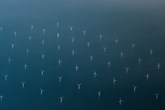WindEurope: the EU only built 16 GW new wind in 2022
Published by Abi Larkin,
Editorial Assistant
Energy Global,
Europe built 19 GW of new wind energy capacity in 2022. 16 GW of those were in the EU. That is 40% up on 2021. But it is much less than what is needed for the EU’s 2030 goals, according to WindEurope. And investments in new wind farms and new wind turbine orders were down in 2022: due to unhelpful government interventions in electricity markets and inflation. The EU and national governments must restore investor confidence. And they must engage proactively to support the European wind supply chain and enable it to grow.
Europe built 19 GW of new wind energy capacity in 2022. Germany built the most followed by Sweden, Finland, France, and the UK. Europe now has 255 GW of wind energy capacity. Those are some of the findings of the WindEurope Annual Statistics report 2022.
87% of the new wind capacity Europe built last year was onshore. There was only 2.5 GW of new offshore wind farms.
Not enough to reach EU targets
The EU-27 built 16 GW of new wind. That is 40% more than in 2021. Over 2023 – 2027, it is now expected that the EU will build 20 GW of new wind every year on average. But that is not enough to reach the EU’s energy and climate targets. The EU needs to build on average 31 GW every year up to 2030. That is achievable if Europe: (a) continues to simplify permitting rules and procedures; (b) restores clear signals to investors; and (c) invests substantially in the wind energy value chain – factories, grids, ports, vessels, and skilled workers.
Turning the corner on permitting
Europe is finally making progress on the simplification of permitting rules and procedures. The EU’s new energy strategy, REPowerEU, has helped a lot, WindEurope state. Last year’s emergency measures on permitting enshrined for the first time that the expansion of renewables is in the ‘overriding public interest’. In Germany, overriding public interest is already unlocking wind energy projects that had been stuck in court cases.
The ongoing revision of the Renewable Energy Directive is key. The trilogues must really nail the improvements on the table: enshrine overriding public interest in the Directive; the clearer definition of the two year permitting deadline; the population-based approach to species protection; and the new rules on repowering.
“Governments are beginning to simplify their permitting rules and procedures for new renewables. Germany is leading the way. They have doubled their rate of new onshore wind permits compared to three years ago. Their average permitting time has dropped to two years. Others must follow suit. Permitting is still the number one bottleneck for the expansion of wind in Europe,” said WindEurope CEO, Giles Dickson.
Inflation and market interventions undermining investment
The share of wind in Europe’s electricity consumption is growing. In the EU27+UK, it is now 17%. The European Commission wants wind to be 43% of EU electricity consumption by 2030. But right now, new investments and wind turbine orders are falling. 2022 saw only 13 GW of new wind farm investments announced. Not a single offshore wind farm reached final investment decision. Wind turbine orders fell by 47% in 2021 to 11 GW.
There are two reasons why wind investments are falling, according to WindEurope.
First is the high inflation in input prices which is insufficiently reflected in developers’ revenues. Higher commodity and other input costs have added 25 – 40% to the price of turbines, but wind farm developers are often stuck with a revenue base that is not indexed in line with this. Governments must fully index their auction prices and tariffs.
Second, a series of unhelpful interventions in electricity markets by different national governments have badly undermined investor confidence. The EU’s upcoming reform of Electricity Market Design must urgently restore this confidence. It must make it clear that emergency measures are temporary and must be aligned between member states. Contracts for difference will play a key role for new investments. But investors must also be allowed to finance their projects with power purchase agreements and on a purely merchant basis if that is what works best for them.
Strengthening Europe’s wind supply chain
Europe’s wind energy supply chain continues to struggle with low volumes (due to unsolves permitting bottlenecks) and inflation in input costs. But it badly needs to grow: Europe does not have enough factories to build all the new turbines it wants.
According to WindEurope, the EU Net-Zero Industry Act should make state aid rules more flexible and facilitate grants and finance for investments in new plant and infrastructure. National investment tax credits have a key role to play. And the European Investment Bank should be allowed to finance individual plant investments.
The idea that Germany and France will benefit much more from this than others is wrong. New investments in offshore foundation manufacturing have just been announced in Spain and the Netherlands. Greece is upgrading a cable plant. And Poland is attracting investments in new turbine factories and port facilities.
For more news and technical articles from the global renewable industry, read the latest issue of Energy Global magazine.
Energy Global's Winter 2022 issue
The Winter 2022 issue of Energy Global hosts an array of technical articles focusing on wind, solar, energy storage, geothermal, and more. This issue also features a regional report on the Australian renewables sector.
Read the article online at: https://www.energyglobal.com/wind/28022023/windeurope-the-eu-only-built-16-gw-new-wind-in-2022/
You might also like
Buchan Offshore Wind submits offshore consent applications
Buchan Offshore Wind has reached a major milestone by submitting its offshore consent applications to Scottish Ministers.

